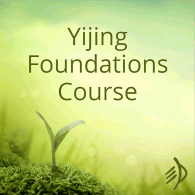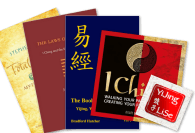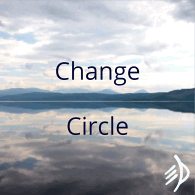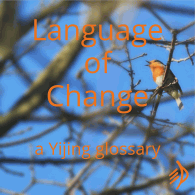Alberto Ramon has been developing his approach to Yijing readings for many years now, and recently published a new book: Conversations with the I Ching. Its subtitle: ‘An intuitive approach to understanding the answers, with 85 explained readings.’ I’m finding it a worthwhile read.
What I like about this book
The Yi is big. It has plenty of areas to research, and abundant space for everyone who wants to develop their own ideas about it and turn them into books. In the midst of all this abundance, I really appreciate the way Alberto focuses in on what works in readings – specifically and in depth. There is nothing in this book at all about ancient China, or the problems of translation, or the structure of the hexagrams, or the Sequence. It’s simply a way of understanding readings: something you can start using, testing out in your own readings, within an hour or so of picking up the book.
His method involves prioritising the reading as a whole: the framework created by the primary and relating hexagram. That’s something I support wholeheartedly – and is not a new idea to anyone at Clarity, of course. But Alberto takes it further: this framework is not just something to consider as you read the text, but the theme, which is the most important feature of the whole reading. He would never consider fragments of text in isolation. From the very first page:
“A complete interpretation of the results from a reading should be a clear message, rather than a collection of texts. One good analogy would be a jigsaw puzzle: after all the pieces have been put together in a certain way, an image emerges. The individual pieces are still seen, but only as part of the image.”
That quotation is a good example of another thing I like about this book: its complete clarity. You may not agree with everything he proposes – I certainly don’t – but you will never be left wondering what he means, or how he arrived at his conclusions. Everything is unpacked for you step by step.
I also appreciate the fact that he does readings, and lots of them: he has developed his method by testing it out in practice. (The book’s probably worth having just for its 85 worked examples.) And he gives good advice on fostering a healthy relationship with the oracle. For instance, if the answer you receive is negative – and by this he means you can’t find anything in it that’s applicable to your question – then it will reveal a new and larger perspective; there is no discarding of readings because they ‘didn’t work’.
He advises asking questions in simple terms that are open to all possible answers, and “should you arrive at more than one question, choose the one that puts you in charge of all your possibilities.” And you should avoid asking too many questions about one issue, or treating the Yi as a “machine” for answers. All this is good.
Things I like less
In this method, the ‘theme’ of the reading, derived from the two hexagrams, is the basis of all interpretation. And the only basis for the theme is Alberto’s own set of hexagram meanings, which occupies some 65 pages at the back of the book. He has carefully, systematically derived these meanings from his reading of the Wilhelm/Baynes (alone). Pick the most applicable meaning from his list for each hexagram, put the two together in a phrase, and you have your theme.
This relegates everything the oracle actually says or does (its words and structure) to a secondary position of only providing ‘clues to be interpreted in relation to the big picture’. And that, in my experience, is just not how readings work. To grasp that ‘big picture’ at all, you need to read the words of your answer and get a feel for its structure. Developing your own sense of each hexagram is immensely useful, but always with the proviso that this should never get in the way of hearing what the hexagram says as if you had never received it before.
He writes,
“If there is any contradiction between the theme and any of the texts, the theme takes precedence, and the contradicting text can be regarded as a precautionary warning, a temporary situation, or a future event or possibility.”
I’d say that if there is a contradiction between your preconceived ideas of the hexagrams’ overall meaning and what the oracle is actually saying, then your ideas of the hexagrams’ meanings need revisiting. Supplanting the oracle’s imagery with abstractions is never a good idea. (A few weeks ago I was talking through Hexagram 45 with a Foundations Class graduate. ‘The king’s presence creates the temple’ meant something for her that had never occurred to me before. This kind of thing happens to me all the time – and of course that’s only possible because I keep on reading what Yi says.)
To be fair, he does advise reading the whole answer – and it is wise to read moving lines and their omens within the context of the hexagram that contains them. (Bradford Hatcher developed that principle into some remarkable interpretations.) But I think Alberto has his interpretive hierarchy exactly backwards here.
There are other niggles, of course. He limits himself to Wilhelm/Baynes, which naturally limits his sense of what hexagrams can mean, and also leaves him stuck in the habit of viewing the two hexagrams only as present and future. That leads to the familiar argument that if you don’t want to end up at the second hexagram, you must read the cast hexagram as a way to avoid it; if you do, you must assume it’s a way to obtain it. My logical mind revolts at this – and more to the point, so does my experience.
What intrigues me
However, I do plan to take my time over exploring his category of ‘negative readings’. By this, he, confusingly, doesn’t mean an answer with a negative omen, but rather one that amounts to a negative response to whatever you proposed. And any answer that contradicts your experience, or is not immediately and directly applicable to your situation, is a negative one. It reveals a disconnection between your idea and the reality, and will probably also be proposing a new perspective – or simply changing the subject.
The book has many examples of this. (Also many positive answers, of course, but those are more straightforward.) Here’s just one:
He had found her through an online dating app, where they had exchanged all of two messages. He asked if this would evolve favourably and received Hexagram 11 with the 5th line changing to 5, Waiting. Following the book’s method, Hexagram 11 means a perfect match (which this couldn’t possibly be at this stage), Hexagram 5 means waiting, and so the marriage imagery in the fifth line must be about someone else, in future. And sure enough, there was never a third message.
One more:
‘Should I pursue pottery as a profession?’ 13.3 to 25. 13 means ‘amateur’ (this is one of the words in 13’s list at the back of the book), 25 means ‘without ulterior motive’, and as neither hexagram has to do with career or professionalism, the answer is ‘no’.
I think this is often going to boil down just to testing your reading against common sense – which is not a bad idea in itself. It does leave me wondering, though, how you would recognise a prediction that went against all common sense and probability. Your reading might paint a picture that bears no relation to your present reality, but what if it’s a picture of the future? If your reading really were saying that this was love at first swipe, how would you know? Carefully focussed questions, and perhaps some follow-up readings, might be in order. (And in the online dating example, the next reading was Hexagram 25 unchanging, which says it all. )
Anyway… as I was saying, this is something I want to explore.
Recommendation
If you’re completely new to the Yi, I don’t think this is one for you. You want to build a habit of reading the texts and visualising the trigram pictures, not skipping them. Also, the book’s lists of hexagram meanings would be a poor substitute for developing your own.
However, if you’re somewhat experienced, have your favourite translations to hand, and would welcome some new, creative ideas on how to navigate the framework of your reading, then this is absolutely worth getting. It offers a fresh perspective on interpretation, and the chance to look at past readings with new eyes.
Conversations with the I Ching is self-published on Amazon US and UK










Dear Hilary,
Thank you for taking the time to review my book. I want to address some of your comments.
First, the theme of a reading is not always the context to understand the texts. Actually, there is an interplay between the theme and the texts. There can be cases where there are several significant phrases formed by the applicable meanings of the resulting hexagrams, and the texts point to the most significant phrase. That is the theme of the reading.
It’s possible that a moving line is beyond the theme, but it must always be interpreted in relation to the theme. That happens especially when the line is in the upper trigram. This case is illustrated by the reading about the U.S. presidential election in 2020, page 50.
It’s not always the case that a result consisting of two hexagrams indicates a present-possible future relationship. There are several other possible patterns connecting both hexagrams, like present situation-advice on how to proceed, etc. This is described in the chapter Symbolic Syntax.
I emphasize that if you’re not sure about the right interpretation, you can always do another reading with a more pointed question or a question from a different angle.
This technique is based on critical thinking. The final answer should satisfy both readings. Knowing that a response must always make sense guided my intuition to determine the correct interpretation of a response.
I started creating the dictionary from the Wilhelm version, but extended the original meanings of the hexagrams to describe current situations, because the I Ching is a timeless tool that deals with every possible situation. Of course the range of meanings of each hexagram must be the same for everyone. For me the set of 64 hexagrams is a spectrum of all possible situations, actions, events, etc. that can be relevant in a reading. Every hexagram is a distinct category of this spectrum.
In general, I didn’t need to consider the trigrams because the texts of the lines are already based on the trigrams. However, only in one reading, A Lost-and-Found-Story, pages 66-67, did I consider the trigrams.
I understand your reservations about the reading on page 80 about pottery, so I changed the answer from “not for profit” to “not as a career.”
If you want to discuss a difficult reading, I’d be glad to give you my interpretation.
Here is my re-interpretation of a reading done by one of your students in 2020:
What will be the outcome of the Coronavirus pandemic?
This reading was done in March 22, 2020. The result consisted of hexagram 55, Abundance, magnitude and hexagram 54, The Marrying Maiden, marriage, contract, duties. By combining the applicable meanings the theme is: “Given the magnitude of this pandemic, everyone has duties.” The image of hexagram 54 explains the duties: “Understanding the transitory in the light of the eternity of the end,” which means understanding the sacrifices to be made so this epidemic can eventually be brought under control. Lines 2 and 3 are about darkness because of the obstruction of the sun, which stands for clarity, so they stand for confusion and not knowing the best course of action. Line 2 is about rousing people through truth and education and line 3 is about breaking one’s arm, casualties. The image of hexagram 55 is about making tough decisions. Since no positive outcome is mentioned, the implication is that it will take a long time for it to be achieved.
Hi Alberto,
Thank you for your detailed response! It’s especially good to have an example reading so people can see how you put things together.
The Logic of Chance (November 2014 revised ed)
I find his dictionary of hexagram meanings is useful for building radial categories (mind-map format) and his triage methods are useful, however, I wouldnot use it as a primary reference. Wilhelm Baynes is a must primary text, if you want to use his version for leveragimg his synonym dictionary entries. One may do as well to use Semantic Primes in conjuction with The Logic of Chance (not Venns)!
The Logic of Chance ( 2014 revised ed)
I find his dictionary of hexagram meanings useful to build radial categories (mind-map format) and his triage methods are useful, however, I would not use it as a primary reference.
Wilhelm Baynes is a must primary text, if you want to use his version for leveragimg synonym dictionary entries. One may do as well to use Semantic Primes in conjuction with The Logic of Chance (not Venns)!